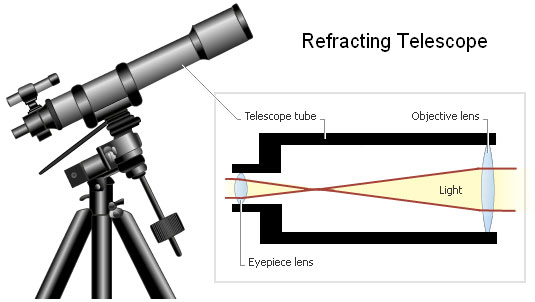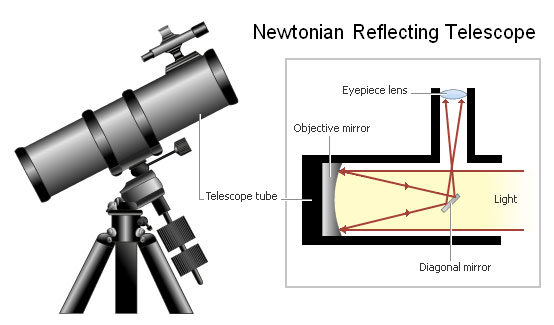
Source: Refracting Telescope, Encarta Encyclopedia 2004
The type of telescope you are most familiar with is a visual, or optical, telescope. This type of telescope uses light from the visual spectrum.
There are two main types of optical telescopes: refracting and reflecting. The objective, which is the part of the telescope that gathers light, determines the type of telescope.
A refracting telescope uses a glass lens as its objective. Actually, refracting telescopes have two convex lenses, one at each end of a long tube. The larger lens, the objective lens, gathers the light coming from an object and focuses the rays to form a real image. The lens closest to your eye is called the eyepiece lens. The eyepiece lens magnifies the image so you can see it clearly. The image you see through a refracting telescope is upside down. Refracting telescopes were the first telescopes built. The diagram below shows a refracting telescope.

Source: Refracting Telescope, Encarta Encyclopedia 2004
A reflecting telescope uses a large concave mirror as its objective. The mirror is close to the rear of the telescope, and light is bounced off (reflected) as it strikes the mirror. The mirror reflects the image to the eyepiece lens. Isaac Newton built the first reflecting telescope in 1668. The picture below shows a reflecting telescope.

Source: Reflecting Telescope, Encarta Encyclopedia 2004
Optical telescopes are not always small like the ones pictured above. The larger the mirror in the optical telescope, the more light it can collect. This results in better images and locating objects farther away in space. Observatories can have optical telescopes that are quite large. The telescope pictured below is an optical telescope with a mirror 3.5 meters in diameter. This telescope is located at the Calar Alto Observatory near Almeria in southern Spain.

Source: 3.5-metre optical telescope, Eckhard Slawik,
Science Photo Library
The McDonald Observatory, which is located in the Davis Mountains of southwest Texas, has 3 large telescopes. The largest is the Hobby-Eberly Telescope which has a 9.2 meter diameter mirror.
![]() Watch this video to learn more about The McDonald Observatory.
Watch this video to learn more about The McDonald Observatory.
Source: McDonald Observatory Yesterday and Today,
McDonald Observatory, YouTube